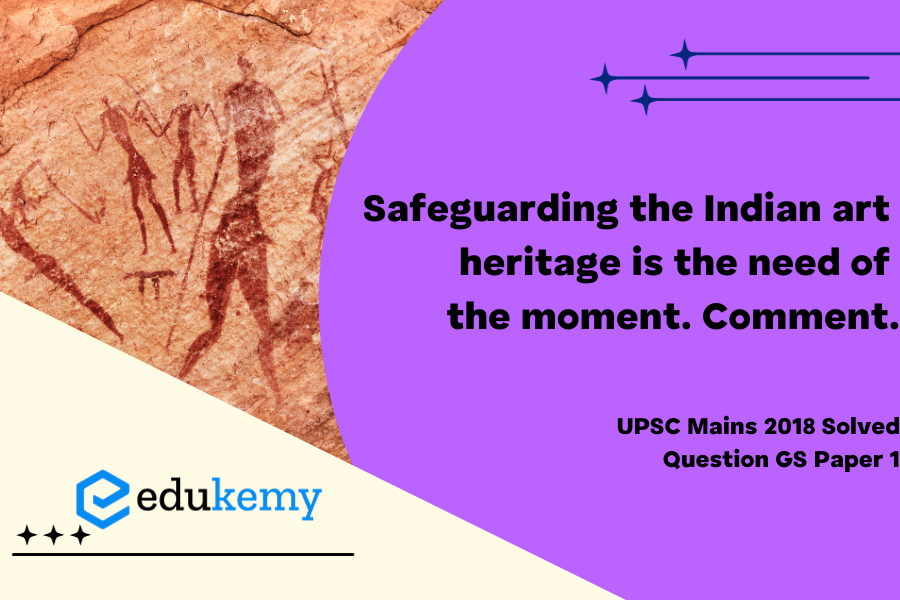Preserving and safeguarding India’s rich and diverse art heritage is an imperative that transcends time and stands as a pressing need in the contemporary era. India, with its millennia-old civilization, boasts a treasure trove of artistic expressions ranging from classical dance forms, intricate sculptures, and vibrant paintings, to traditional crafts that encapsulate the country’s cultural identity. The urgency to safeguard this invaluable heritage is underscored by the rapid pace of modernization, globalization, and the accompanying threats of cultural homogenization. As urbanization expands and technology reshapes societal norms, there is an inherent risk of neglecting and losing the essence of India’s artistic legacy. The need to protect and promote this heritage is not merely an aesthetic concern; it is a crucial step toward fostering national pride, identity, and continuity. Preserving the Indian art heritage is not a nostalgic endeavor but a strategic investment in cultural resilience, ensuring that the richness of the past continues to inspire and resonate with generations to come.
Tag: Indian culture.
Contents
Decoding the Question:
- In the Introduction, try to define Indian art heritage. Also, highlight the components of Indian Art heritage.
- In Body, elaborates on the need to safeguard the Indian art heritage.
- Conclude by giving examples of schemes or Constitutional backing to safeguard Indian art heritage.
Answer:
The term heritage has wide connotations spanning across nature, culture, food, and other dimensions. Art heritage primarily refers to the tangible and intangible heritage comprising Paintings and art forms, Ancient Monuments and Archaeological Sites, Sculptures, Artifacts, etc. Indian art heritage reflects the faith principles, norms, and perspective of the country. So, they are of special value and are worthy of safeguarding.

Indian art heritage is “fragile wealth”, and they are required to be preserved and cherished because once lost, they are nonrenewable.
Preserving and protecting this heritage is essential for several reasons:
- 1. Historical and Cultural Identity: Indian art heritage reflects the country’s rich history, cultural diversity, and unique artistic traditions. It serves as a link to our past, providing valuable insights into the social, religious, and artistic practices of different eras. Safeguarding it ensures that future generations can connect with their roots and understand their cultural identity.
- 2. Educational Value: Indian art heritage has immense educational value. It is a valuable resource for researchers, scholars, and students studying various aspects of history, art history, archaeology, anthropology, and related disciplines. Preserving and documenting this heritage provides a wealth of knowledge for academic pursuits and encourages further research.
- 3. Economic Importance: The Indian art heritage also has significant economic implications. It attracts domestic and international tourists, contributing to cultural tourism and generating revenue. Preservation efforts can help in developing sustainable cultural tourism initiatives, creating employment opportunities, and promoting local economies.
- 4. Artistic and Aesthetic Appreciation: Indian art forms, such as classical dance, music, painting, and sculpture, are revered globally for their beauty, intricacy, and unique expressions. Safeguarding the art heritage ensures that these art forms continue to thrive, enabling artists to learn and draw inspiration from traditional techniques and styles.
- 5. Environmental and Material Conservation: Many Indian art forms rely on natural materials and traditional techniques. By safeguarding the art heritage, we promote sustainable practices, the conservation of natural resources, and the preservation of traditional craftsmanship.
To effectively safeguard the Indian art heritage, various measures are necessary. These include:
- Proper documentation and cataloging of art objects and heritage sites.
- Conservation and restoration of deteriorating artworks and structures.
- Public awareness campaigns to promote the value of art heritage and encourage responsible tourism.
- Strengthening legislation for the protection of heritage sites and cultural artifacts.
- Encouraging research, education, and training in art conservation and restoration.
- Collaboration between government agencies, cultural institutions, and local communities for the preservation and maintenance of art heritage.
In conclusion, Preserving the heritage is enshrined as a Fundamental Duty (Article 51 A) in the Indian Constitution. Also, Article 49 makes it clear that the obligation to protect these sites is of the State. Institutions like, the Archaeological Survey of India (ASI) are charged with the preservation of physical and tangible heritage that is accumulated in the ancient monuments and archaeological sites.
In case you still have your doubts, contact us on 9811333901.
For UPSC Prelims Resources, Click here
For Daily Updates and Study Material:
Join our Telegram Channel – Edukemy for IAS
- 1. Learn through Videos – here
- 2. Be Exam Ready by Practicing Daily MCQs – here
- 3. Daily Newsletter – Get all your Current Affairs Covered – here
- 4. Mains Answer Writing Practice – here


